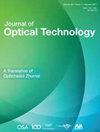Comparative analysis of design algorithms for optical systems using composite holographic optical elements
IF 0.5
4区 物理与天体物理
Q4 OPTICS
引用次数: 0
Abstract
Subject of study. Two algorithms for designing an optical scheme based on a composite hologram optical element aimed at optimizing the diffraction efficiency are presented. The first algorithm is based on the successive partitioning of the hologram element, and the second is based on averaging locally the optimized hologram parameters. Aim of study. The aim of this study is to achieve high and uniform diffraction efficiency in the working spectral range using design and modeling techniques to determine the parameters of a composite hologram. This is realized by selecting the optimal configuration of the composite hologram and its parameters in each sub-aperture. Methods. The algorithms are based on the application of the Welford equation for ray tracing through a hologram and Kogelnik theory for simultaneous calculation of diffraction efficiency in several sub-apertures. Main results. As a demonstrative example, the design and analysis of a spectrograph optical scheme operating in the near-infrared region with a high angular dispersion are presented. A diverging beam with a numerical aperture of 0.14 is fed to the input of the spectrograph. The spectrograph operates in the wavelength range from 830 to 870 nm, the center of which corresponds to the emission wavelength of a standard laser source. The optical system comprises a collimator, two volume-phase transmission holographic gratings, a camera lens, and a photodetector. It is shown that the highest gain in diffraction efficiency for a composite hologram comprising three rectangular sub-apertures reaches 5.1 times that of a single hologram grating without parameter optimization, observed at the long-wavelength edge of the spectrum. Practical significance. The proposed algorithms will allow one to determine the optimal number, shape, and location of composite hologram sub-apertures. The obtained results will make it possible to design a spectrograph characterized by an increased and more uniform image brightness over the entire working range.复合全息光学元件光学系统设计算法的比较分析
研究主题。提出了两种以优化衍射效率为目标的复合全息光学元件光学方案设计算法。第一种算法是基于全息图元素的逐次划分,第二种算法是基于优化后的全息图参数的局部平均。研究目的。本研究的目的是利用设计和建模技术来确定复合全息图的参数,在工作光谱范围内实现高而均匀的衍射效率。这是通过选择复合全息图的最佳结构及其在每个子孔径中的参数来实现的。方法。该算法基于全息图光线追踪的Welford方程和同时计算多个子孔径衍射效率的Kogelnik理论。主要的结果。作为一个实例,本文介绍了一种高角色散的近红外波段摄谱仪光学方案的设计和分析。将数值孔径为0.14的发散光束送入光谱仪的输入端。摄谱仪工作波长范围为830 ~ 870 nm,其中心对应于标准激光源的发射波长。该光学系统包括一个准直器、两个体相传输全息光栅、一个照相机镜头和一个光电探测器。结果表明,在光谱的长波长边缘处,由三个矩形子孔组成的复合全息图的衍射效率最高增益达到了未经参数优化的单个全息图光栅的5.1倍。现实意义。所提出的算法将允许人们确定复合全息图子孔径的最佳数量、形状和位置。所获得的结果将使设计具有在整个工作范围内增加和更均匀的图像亮度的光谱仪成为可能。
本文章由计算机程序翻译,如有差异,请以英文原文为准。
求助全文
约1分钟内获得全文
求助全文
来源期刊
CiteScore
0.90
自引率
25.00%
发文量
66
审稿时长
3-8 weeks
期刊介绍:
The journal publishes design details of a diversity of optical instruments, along with a strong section on computational optics useful to engineers, mathematicians, and physicists, as well as optical scientists. Issues of the English translation volume are published by OSA and appear at the same time as the Russian language edition, Opticheskii Zhurnal, which is produced by the Vavilov State Optical Institute

 求助内容:
求助内容: 应助结果提醒方式:
应助结果提醒方式:


